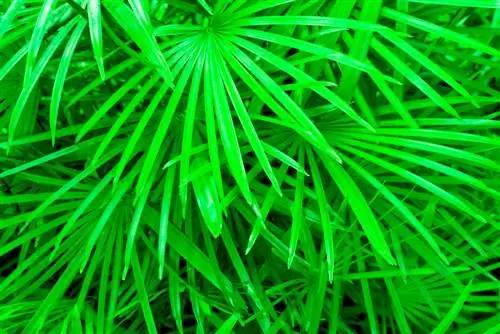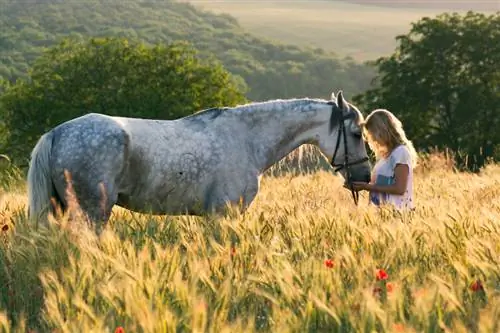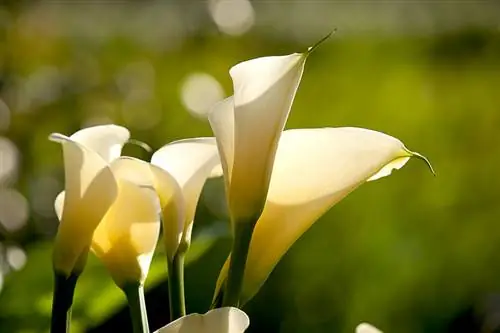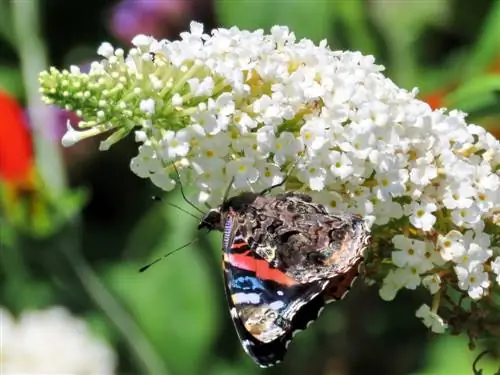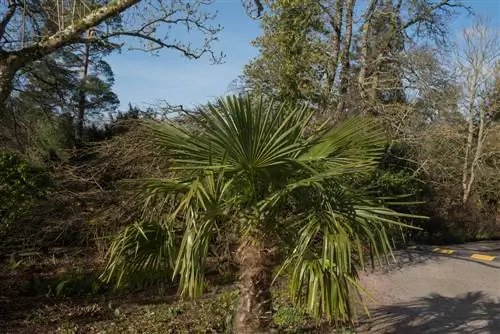- Author admin [email protected].
- Public 2023-12-25 17:45.
- Last modified 2025-01-23 11:21.
Livistona palms decorate offices and living rooms as foliage plants. Their culture is not difficult if the requirements for temperature and light are taken into account. In the right location, the umbrella palm proves to be robust, so it requires little attention in terms of care.
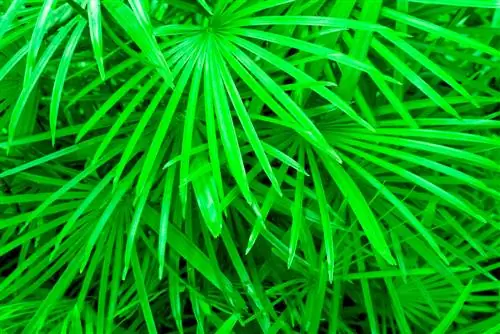
How do I care for a Livistona palm?
The Livistona palm is an easy-care plant that grows in a well-drained substrate and prefers a bright location with indirect sunlight. To keep the palm tree he althy, you should water it regularly, fertilize it and transplant it if necessary. It is non-toxic and works well indoors.
Origin
Behind the name Livistona there is a genus that belongs to the palm family. The plants are mainly found in Southeast Asia. In the north their range extends into the Himalayas. In the south the species occur in Indochina, New Guinea and Malesia. There are some habitats in Australia and the Horn of Africa where Livistonia species thrive.
Their habitats are very different. The species known as umbrella palms inhabit swamp and mountain forests or areas near freshwater rivers and streams. They occur in the understory of tropical and subtropical rainforests and characterize the dry woody vegetation in the savannah. Livistona species also grow in desert canyons that have continuous water.
Growth
The plants grow as single-trunk palms whose height varies greatly. Some species remain dwarf, while other representatives of the genus reach several meters high. Their stems are formed by layered leaf sheaths that dry out over time. When grown in pots, the ornamental plants usually grow as stemless shrubs.
leaves
Livistonias develop leaves that give the plant an exotic character. They are divided into a fan-shaped leaf blade with stiff or slightly drooping leaf sections and a stem that can be spiny or glabrous. When the leaves wither, they remain on the plant. The dead leaves form a kind of dress around the trunk. Depending on the species, the leaf blade can be up to 60 centimeters long.
Bloom
The flowers are tightly packed together in inflorescences. They grow from the leaf axils and can branch up to five times. Umbrella palms are hermaphroditic. Only a few species develop purely male and female plants. The individual flowers are very small and mostly cream-colored. Livistonias bloom several times a year. Plants cultivated indoors rarely develop flowers because the room conditions do not correspond to natural conditions.
Fruit
After flowering, the inflorescence is covered in small, spherical fruits. Their coloring differs depending on the species. The color range ranges from scarlet and green to blue-green, blue-black and dark brown to black.
Usage
Livistonias decorate pot gardens on balconies and terraces during the summer months. They are only suitable for planting in containers and beautify living rooms, winter gardens or light-flooded passage areas. In combination with other exotic plants, a tropical atmosphere is created.
Livistonias feel at home between these plants:
- Coconut palm
- Single sheet
- Klivie
Is Livistona poisonous?
Umbrella palms do not contain any toxic substances and can therefore be cultivated safely in households with children or pets. The sharp leaves and spiny petioles of some species pose a risk of injury. Place the bucket out of the reach of small children, cats or dogs. Fallen leaves should be disposed of quickly.read more
Which location is suitable?
A bright location offers Livistonia optimal growing conditions. The plants can tolerate several hours of direct sunlight as long as they are not exposed to the blazing midday sun. The darker the location, the slower the palm tree grows. In sunnier areas, the plant should be misted regularly. It thrives optimally at temperatures between 18 and 25 degrees Celsius.
What soil does the plant need?
Livistonia species should be cultivated in a well-drained soil mix that provides slightly acidic conditions. A mixture of potting soil, compost and sharp-edged sand is ideal. For improved permeability, you can alternatively use gravel, lava granules or expanded clay. You should avoid pure peat and humus soil. The substrate collapses over time, meaning the roots are no longer adequately ventilated.
Propagate Livistona
Umbrella palms can be propagated using seeds from mature fruit heads. The seeds are available in specialist shops for Mediterranean plants and palm trees. Place the seeds in a shallow bowl of lukewarm water and let the seeds soak for 24 hours. During this time the outer shell softens and the seeds can germinate more easily.
Germination occurs at different speeds. It can take up to four months until the first shoot tips appear. It is favored by a temperature of 25 degrees Celsius.
Livistona in the pot
Livistonia requires a sufficiently large pot made of clay or terracotta that has enough drainage holes. If you use a plastic container with a planter, you should cover the bottom of the pot with stones. The irrigation water collects here and poses no danger to the roots. The water evaporates and creates a moist microclimate.
This is what the right planter looks like:
- deep so that the taproots have enough space
- heavy to ensure stability
- larger than the root ball
Balcony
During the summer months, the umbrella palm enjoys an outdoor location. You should slowly get used to the outdoor conditions, because the intense UV radiation on the balcony and terrace causes damage to the leaves.
Put the pot in a protected and shady place for the time being and bring it back in in the evening when the temperature drops below ten degrees Celsius. If the thermometer remains in the double-digit range, the plant can stay outside at night. After two weeks, the leaves have developed a natural protection against the sun's rays, so that the umbrella palm can move to a sunnier place.
Pouring Livistona
Livistonias have medium water requirements between spring and autumn. Water the palm tree evenly so that the root ball does not dry out or get wet. It should be moistened to the bottom. Allow the soil to dry slightly between watering. If the summer months are very hot, you should check the substrate every two to three days.
During the cool winter period, it takes longer for the soil surface to dry. During this time, it will not harm the plant if two thirds of the substrate are dry.
Good to know:
- Livistonia can also tolerate low humidity between 40 and 60 percent
- In winter, place a bowl of water next to the bucket
- soft and stale tap water or rainwater is ideal
Fertilize Livistona properly
If you have bought a new umbrella palm or have recently repotted it, you no longer need to fertilize it in the same year. The existing nutrients contained in the finished substrates are sufficient for the plants. From the second year onwards, you can supply the plant with a special fertilizer for palm trees (€6.00 on Amazon) every two weeks or monthly between spring and autumn. Alternatively, you can use fertilizer sticks that are inserted into the substrate in spring and summer.
Cut Livistona correctly
Pruning damages the plant because it only has one point of vegetation. Dead leaves can be removed regularly. Wait until the leaves dry completely. This saves the plant stress because it draws excess nutrients from the fronds. Cut off the dead leaf near the base, leaving a piece of the petiole. This makes the trunks appear thick and even.
How do I transplant correctly?
Repotting every two to three years is recommended so that the roots have more space again. This measure takes place between March and April, before the new growth phase begins. Place the root ball in a slightly larger container. Completely replace the substrate with fresh soil.
Wintering
The dormant phase begins in October, during which livistonia hardly grow. The pots can be placed in an unheated room where bright conditions prevail. Most umbrella palms can tolerate a temperature drop to ten degrees Celsius during this time. Livistona rotundifolia requires temperatures between 13 and 15 degrees Celsius. Adjust the watering to the temperature and avoid fertilizing. From February onwards, intensify the watering rhythm and supply the plant with nutrients again.
Pests
If the site conditions are suboptimal, Livistona species can be attacked by pests.
Scale insects
If you look closely, these pests can be easily identified. The lice live under a hardened shield made up of secretions. Scale insects stay in one place and suck plant sap from the leaf veins. Only when there is a severe infestation are clear signs visible on the plant. Their leaves wither and slowly die.
In order to combat scale insects sustainably, systematically effective poisons are necessary. These are available in stick form or as a liquid and are absorbed by the plant. The active ingredients spread through the plant juices and effectively kill the pests.
Thrips
If the air in the room is too dry, thrips occasionally spread on the leaves of Livistonia and damage the plant. It shows growth disorders and silvery white spots on the leaves. If the infestation is severe, the leaves die. Agents that are absorbed by the plant and distributed throughout the organism via the plant sap have proven to be effective. To prevent an infestation, you should ensure high humidity, especially in winter.
Brown leaves
If the umbrella palm is placed directly in the sun after showering, the still wet leaves will quickly develop brown spots. Instead of a shower head, use a fine spray bottle to wet the plant with water. The leaf tips turn brown if the plant is too wet or too dry.
Tip
Livistonias are sometimes called fan palms, but you should not confuse the palm family with the related Washingtonia species.
Varieties
- Chinese umbrella palm: leaves cut almost to the base. Up to 12 meters high, lower as a container plant.
- Australian umbrella palm: Robust species with a gray-brown trunk, covered with fibers. Leaves cut to the base. Up to 15 meters high, smaller in a pot.

